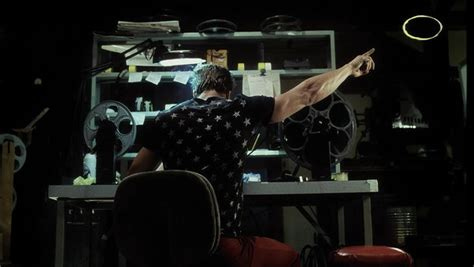Week 80 posts include shots from The Haunting of Bly Manor (2020); Ponyboi (2019); Stranger on the Third Floor (1940); Jackie Brown (1997); and Fight Club (1999).
The Haunting of Bly Manor
Mike Flanagan shows are full of match cuts, clever editing from one item-or-person-to-similarly-framed-thing. This from The Haunting of Bly Manor 1.02 “The Pupil” is one of my favourites; not just the cheeky match cut itself, but how that cut conspicuously draws attention to the basement door, which leads to a chilling realisation 15 seconds later.
As the fridge and basement doors open simultaneously (0:11), we're suddenly plunged from the bright kitchen into darkness — the opposite of what one expects as doors open!
The darkness is half-erased as Dani opens the door, so we see the cut ‘jumped’ us into the basement.
Dani stands at the stairs for a few moments as the light switch fails to work; a cut to Dani's POV for a moment and hoooold on the creepiness, before Owen speaking J-cuts us back to the kitchen.
In the kitchen, not only is there no sign of Dani but *the door is closed,* which attention is drawn to by Owen's OJ carafe.
The J-cut (where sound/dialogue starts before we cut to the scene where the sound/dialogue is coming from) makes the scenes feel continuous, which is how we can tell the door being closed is not a continuity error but a choice. Because it cut from Dani's POV in a still shot, we wonder "Is she standing there but Owen and Clara are no longer aware of her? Is time moving differently in the basement than the kitchen? What has happened?”
The fun doors match cut serves a purpose in drawing our notice, right before the basement door is featured in a shot doing what The Haunting of Bly Manor does so well: a background element which creates a vague sense of unease.
Jackie Brown
When Jackie Brown offers Max Cherry a cup of coffee, she's doing it to distract him, to give herself a reason to avoid his eyes and certain topics. But reaching for coffee also gives her and Max pretext for conversation — a very Noir excuse, as I wrote about elsewhere.
Tarantino also makes good use of the ritual, using mug shots (pun very intended) to break up the scene, sometimes hiding Jackie's face, and keeping conversation and edit smoothly flowing til Jackie & Max come to settle down across the table from each other.
Stranger on the Third Floor
Stranger on the Third Floor (1940) has a lot to convey in its short 64 min runtime.
What better way to communicate landlord Albert Meng is a mean creep than to high-contrast -light and shoot him from below, encircling him with 'jail bar' railing below and shadows above?!
No dialogue needed, just VIBES.
Ponyboi
Ponyboi (short 2019, feature coming 2024) encapsulates so much in these shots:
the headlights behind through the window, which crossfade into a sea of headlights on the highway signifying what Ponyboi sees as freedom
the look of longing at the Mustang just out of frame which stops Ponyboi short, meanwhile behind him a pay-to-ride pony and a beautifully lit laundromat
the cowboy inside, behind glass and out of focus
a shot of the mustang coming literally into focus; it's not a dream, it's solidly there
finally Ponyboi stepping through the haze and walking up to his dream
Fight Club
How does someone - or CAN anyone? - break the fourth wall without looking at the camera?
Does this shot count?
Stu and Mel look at a few unique instances from Fight Club in this special episode of Draft Zero! (Spoiler: we argue it counts.)





